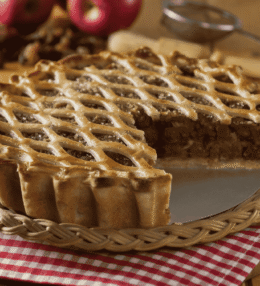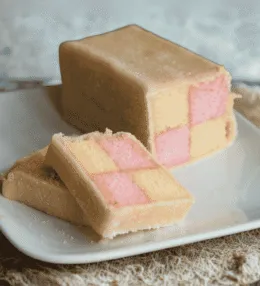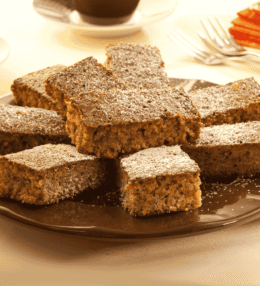
- View
Table of Contents
ToggleFritule are small doughnut-like sweets from Croatia that are fried until golden and often dusted with icing sugar. Light, round, and slightly crisp on the outside, they offer a tender interior that carries hints of citrus and spice. They are beloved across the country, especially during festive times.
Although simple in form, Fritule hold a special place in Croatian kitchens. They are prepared for Christmas, weddings, and village celebrations, where bowls of them are shared freely. Each batch is made to be eaten quickly, often still warm from the pan.
What makes Fritule appealing is not only their sweetness but their inviting texture. They are easy to enjoy with coffee or wine, and though similar to doughnuts, their flavour is distinct. They feel both traditional and timeless, carrying a homely charm.
Want to dive deeper into Croatian Cuisine? Don’t miss our post on Traditional Croatian Foods to Try
What Is Fritule?
Fritule are bite sized fried dough balls, usually flavoured with lemon or orange zest and sometimes enhanced with a splash of local spirits such as rakija or rum. They are fried in hot oil until puffed and golden, then dusted with sugar.
Though often compared to doughnuts, they differ in both size and taste. Fritule are smaller, usually no larger than a walnut, and their dough is lighter. They can be served plain, with raisins inside, or topped with a drizzle of honey.
They are eaten warm, though they hold their flavour well at room temperature. Whether made for holidays or casual gatherings, they remain a symbol of togetherness, meant to be shared among family and friends without ceremony.
Ingredients and Taste
The dough for Fritule is simple, typically made from flour, eggs, sugar, and milk. Baking powder is often used to give the dough its rise. Citrus zest is a key flavour, and raisins or brandy may be added for warmth and depth.
When fried, the dough balls develop a crisp outer layer that gives way to a soft, slightly chewy centre. The flavour is mildly sweet, brightened by citrus, with occasional bursts of fruit or liqueur. Each bite feels comforting without being heavy.
They are usually finished with a dusting of icing sugar, which adds a delicate sweetness. Some variations use melted chocolate or honey instead, showing how flexible the recipe can be. Despite the variations, their essence remains simple and familiar.
A Taste of History
Fritule trace their roots to the Adriatic coast, particularly Dalmatia and Istria, where influences from Italian and Venetian cuisine were strong. They resemble fritters found across the Mediterranean but have developed a character unique to Croatia.
Traditionally, they were prepared during Christmas and New Year festivities. Families would gather in the kitchen, with generations working together to fry and serve them. The sweets carried a sense of ritual, marking celebration and continuity.
In coastal towns, they often included local flavours such as rakija or citrus from nearby groves. This tied the dish closely to its surroundings, giving it a taste that reflected both place and season. Fritule became an edible marker of identity.
Today, they are enjoyed beyond the holidays. Street stalls and bakeries across Croatia sell them year round, and tourists quickly discover their charm. Yet in family kitchens, they remain tied to celebration, a dish that brings people together through shared tradition.
How to Make Fritule (Fried Sweet Dough Balls)
Fritule are a cherished Croatian treat, often prepared during holidays and family gatherings. These bite sized golden dough balls carry hints of citrus, raisins, and a gentle sweetness. Expect a light, airy interior with a crisp finish. See the recipe card at the bottom for printable directions
Ingredients
For the dough
- 250g plain flour
- 1 egg
- 150ml plain yoghurt (or buttermilk)
- 1 tbsp sugar
- 1 tbsp rakija (fruit brandy) or dark rum
- Zest of 1 lemon
- Zest of 1 orange
- ½ tsp baking powder
- ½ tsp salt
- 50g raisins (soaked in warm water or rum for 15 minutes)
For frying
- Vegetable oil (sunflower or rapeseed, for deep frying)
For serving
- Icing sugar, for dusting
Cooking Instructions
Step 1: Prepare the raisins
To begin, soak raisins in warm water or rum for 15 minutes. This softens them and infuses extra flavour. Drain well before adding to the dough. Transition to mixing the batter.
Step 2: Mix dry ingredients
In a large bowl, combine flour, baking powder, salt, and sugar. Whisk lightly to distribute the leavening and sweetness evenly. Move to blending wet ingredients.
Step 3: Blend wet ingredients
In a separate bowl, beat the egg with yoghurt, rakija (or rum), and citrus zest. Whisk until smooth and aromatic. Transition to combining wet and dry mixtures.
Step 4: Make the batter
Gradually fold the wet mixture into the flour blend. Stir until a sticky dough forms, then gently mix in the raisins. Avoid over mixing to keep fritule light. Transition to preparing oil for frying.
Step 5: Heat the oil
Pour vegetable oil into a deep pan, enough to cover the fritule as they fry. Heat over medium until it reaches around 170°C. Test by dropping in a small bit of dough, it should rise slowly and bubble. Move to frying.
Step 6: Fry the fritule
Using a teaspoon or small scoop, carefully drop portions of dough into the hot oil. Fry in batches for 3–4 minutes, turning occasionally until golden brown and puffed. Transition to draining.
Step 7: Drain and cool
Remove fritule with a slotted spoon and place them on kitchen paper to drain excess oil. Allow to cool slightly before dusting. Prepare for serving next.
Final Step: Serve warm
Arrange fritule on a platter and dust generously with icing sugar. Best enjoyed warm with coffee, dessert wine, or simply as a festive snack.
Variations and substitutions
- If rakija is unavailable, substitute with dark rum or omit entirely.
- Buttermilk can replace yoghurt for a similar tangy richness.
- Add a pinch of cinnamon or vanilla extract for aromatic variation.
- If raisins are not preferred, swap with finely chopped dried figs or currants.
Cooking Tips for Perfect Fritule
- Keep the batter slightly sticky; a dry dough makes heavy fritule.
- Do not overcrowd the frying pan, as it lowers oil temperature.
- Maintain steady oil heat for even colour and puff.
- Soak raisins ahead to prevent them burning in hot oil.
- Dust with sugar only after cooling slightly so it clings without melting.

Croatian Fritule (Fried Sweet Dough Balls)
Ingredients
For the dough
- 250 g plain flour
- 1 egg
- 150 ml plain yoghurt or buttermilk
- 1 tbsp sugar
- 1 tbsp rakija fruit brandy or dark rum
- Zest of 1 lemon
- Zest of 1 orange
- ½ tsp baking powder
- ½ tsp salt
- 50 g raisins soaked in warm water or rum for 15 minutes
For frying
- Vegetable oil sunflower or rapeseed, for deep frying
For serving
- Icing sugar for dusting
Instructions
- To begin, soak raisins in warm water or rum for 15 minutes. This softens them and infuses extra flavour. Drain well before adding to the dough. Transition to mixing the batter.
- In a large bowl, combine flour, baking powder, salt, and sugar. Whisk lightly to distribute the leavening and sweetness evenly. Move to blending wet ingredients.
- In a separate bowl, beat the egg with yoghurt, rakija (or rum), and citrus zest. Whisk until smooth and aromatic. Transition to combining wet and dry mixtures.
- Gradually fold the wet mixture into the flour blend. Stir until a sticky dough forms, then gently mix in the raisins. Avoid over mixing to keep fritule light. Transition to preparing oil for frying.
- Pour vegetable oil into a deep pan, enough to cover the fritule as they fry. Heat over medium until it reaches around 170°C. Test by dropping in a small bit of dough, it should rise slowly and bubble. Move to frying.
- Using a teaspoon or small scoop, carefully drop portions of dough into the hot oil. Fry in batches for 3–4 minutes, turning occasionally until golden brown and puffed. Transition to draining.
- Remove fritule with a slotted spoon and place them on kitchen paper to drain excess oil. Allow to cool slightly before dusting. Prepare for serving next.
- Arrange fritule on a platter and dust generously with icing sugar. Best enjoyed warm with coffee, dessert wine, or simply as a festive snack.







Leave a Review